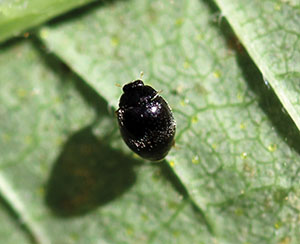When the Whole Farm Is the Region
 |
|
Black ladybird beetles can control European red mites. Photo by Whitney Cranshaw, Colorado State University, Bugwood.org. |
The idea of “whole farm” pest management came to life recently for growers in the Northeast.
In 2014, the Northeastern IPM Center awarded a $49,487 Partnership Grant to Katie Campbell-Nelson, Ann Hazelrigg, and Andy Radin to build and maintain the New England Fruit and Vegetable Scouting Network.
Using field walks at sentinel farms in Vermont, Massachusetts, and Rhode Island, the team provided growers with hands-on training in IPM methods for key pests and diseases in vegetable and fruit crops. Then they distributed weekly pest alerts to an audience of over two thousand people.
When you think of the region as the whole farm, now you’re really talking.
“Mother Nature has given us incredibly powerful tools.”
The entomologist Joe Lewis is often quoted for a simple message: “Let’s learn how to use Mother Nature’s tools.” Across the country, researchers are finding that whole-farm, ecological systems work. In Pennsylvania, for a positive example, 80 percent of apple growers now rely on the black ladybird beetle to control European red mites.
For a negative example, in Eastern states, corn and soybean growers have watched at least ten species of annual weeds become resistant to triazine herbicides. Now, in no-till systems, producers use four to five different herbicides to control the weeds once stopped by atrazine. Similarly, the costly Colorado potato beetle has become resistant to many pesticides.
Single-tool management ignores basic ecological principles, and fails because it does not consider problems as symptoms of a system whose intricate natural controls have collapsed.
Strategies for managing pests
“The laws of nature demand that we look at the whole system,” says John Teasdale, a weed scientist with USDA’s Agricultural Research Service in Beltsville, Maryland.
In order to maintain populations of beneficial insects against pest organisms, growers can follow some specific strategies and practices. First, they can leave some undisturbed areas on a farm.
Agricultural disturbances such as tillage, harvest, and fertilizer and pesticide application all can provoke pest problems, but there are ways to avoid stimulating pests at the wrong time. For example, till fields before final seedbed preparation to stimulate weed germination, then cultivate before planting to lower the density of weeds infesting a crop.
Diversity, both in the crops grown and how they are managed, can reduce pest problems, and decrease the risks of market and weather fluctuations. Growers can enrich diversity across the landscape, throughout the season, and from year to year.
Cultivate rich soils
As plant variety spreads above ground, diversity builds in the soil. Through a system of checks and balances, a medley of soil organisms helps maintain low populations of many pests.
“You can redesign the farm to become a more complex agricultural ecosystem,” says Teasdale. “In an agroecosystem, the crop is going to dominate. But within that much simpler, very managed system, we can apply many principles from natural ecosystems to make it easier to control pests.”
Campbell-Nelson and the New England Fruit and Vegetable Scouting Network are aiming toward a goal of a farm that mimics nature. And good work on one farm can spread by communication to the broader region, and beyond.
For further exploration: John Vandermeer of the University of Michigan describes the linkages between predator-prey insects in coffee. Start the video at 30:00 to hear him describe ants, flies, and beetles in particular. http://neipmc.org/go/Wfcj
This issue was produced in partnership with the Sustainable Agriculture Research and Education (SARE) program, which provided text and examples. See http://neipmc.org/go/aLjm for the 20-page bulletin that inspired this issue.
— by CHRIS GONZALES
The Northeastern IPM Center promotes integrated pest management for reducing risks to human health and the environment. If republishing our news, please acknowledge the source (“From Northeast IPM Insights”) along with a link to our website.
